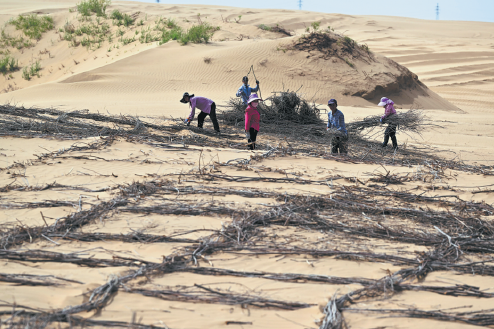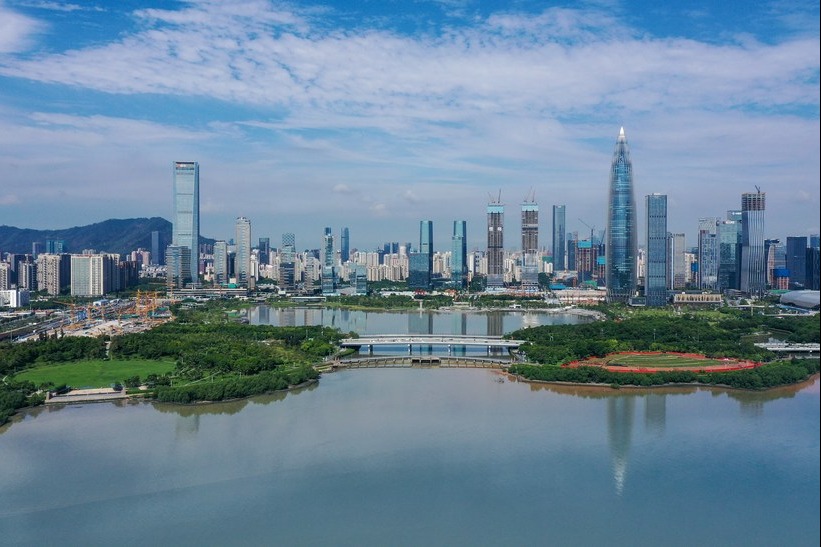Jinyun's green transformation through the lens of a Zimbabwean scholar

As a scholar from Zimbabwe, a country on its own path to sustainable development, my first encounter with China's "Two Mountains Theory" was one of profound curiosity. That moment came during the 2023 China-Zimbabwe Jinyun Transcultural Dialogue in Jinyun county, Zhejiang province in east China. I saw a green paradise and a vibrant local economy. It was during this visit that I first heard of the now-famous slogan, "Lucid Waters and Lush Mountains are Invaluable Assets", and I knew the glossy surface hid a deeper story of the transformation.
Now, returning to China in 2025 as a visiting scholar in the School of Journalism and Communication at Tsinghua University, I have had the privilege of undertaking collaborative research to discover more beneath the surface. Our team undertook a comprehensive study of both the county government's reports and the human aspect of the transformation. My return, coinciding with the 20th anniversary of the articulation of the "Two Mountains Theory" in Zhejiang province, was also an inspiring experience. While our collective goal was to document this change, my personal mission as the foreign scholar on the team was to understand how areas within Jinyun county, such as Xiandu district and Gao Fan village in Da Yuan township, had attained the lush mountains and lucid waters.
The review of the official discourse shows that Jinyun county's government began a deliberate process of renaming and reimagining its identity. "Industry" was re-branded as "ecological industry". "Agriculture" was elevated to "ecological boutique modern agriculture" and tourism was no longer just about visitors, but about creating "hometown nostalgia tourism", a culturally rich experience. In addition, local products like the savory Jinyun Shaobing were transformed from simple commodities to "golden business cards" for the county's new green identity.
Our research also uncovered the most critical element of Jinyun's success, compelling narratives, stories of bold vision, immense local sacrifice, financial risk, and a journey from deep-seated skepticism to earned trust. The transformation to Lush Mountains and Lucid Waters in selected villages was a tale of two transformations: one born of economic collapse and regulatory force, the other of immense local sacrifice and faith.
To understand Jinyun county's triumph, one must first appreciate the depth of its past struggles. For decades, Xiandu's economy, like many places in the country, was heavily reliant on extractive industries, especially stone quarrying, which was a way of life for every household. At the same time, other communities in the county, such as Gao Fan village, faced "grey waters" of waste. Their problem was not industrial quarries. The 'grey mountain' was personal. Their local river, the heart of their community, had become a dumping ground for construction and domestic waste. The environmental crisis was not an abstract problem, but of foul water and choked streams in their backyards.
The official narrative often credits the "Two Mountains Theory" for the entire transformation, but we found the stories to be more complex. The shift from the stone economy was not wholly driven by this inspirational slogan but by a harsh reality. The stone industry collapsed between 1997 and 1999, crushed by the arrival of efficient cutting machines, the fall of steel and cement prices, and the sudden proliferation of local red brick factories. As a former official from the county's Bureau of Geology and Mineral Resources recalled, at their peak, there were nearly 40 kilns in Jinyun, offering a cheaper and more accessible alternative that stone, for all its abundance, could no longer compete with.
The final blow was not persuasion, but regulation and safety. A fatal domino collapse in 2003, which killed two workers, showed the extreme dangers of quarries dug too close together. The county government responded by enforcing new rules and sealing the pits. For the community, this was not a moment of hope but of desperation. The primary concern was economic survival. The desperation was palpable. A striking memory shared by the previously mentioned official has stayed with our team. He recounted how, after the county began to fully close the pits around 2000, he personally painted the large character for 'closed' at the foot of the quarry. When he returned years later, he was stunned to find the character had moved halfway up the mountainside. The villagers had secretly quarried away the entire base of the mountain beneath it, a testament to their reliance on the stone economy.
Instead of blasting and backfilling the massive quarry voids, a new vision emerged in the form of repurposing these industrial wounds. After the history of stone quarrying in Xiandu, the quarries were transformed into utility-based public infrastructure for exhibition, teahouses, along with platforms for visitors to observe sunsets through uniquely chiseled rock faces. This was coupled with restaurants to cater to guests, and an educational centre for processing natural stone. This vision was championed by those who knew the quarries best. As the former geology bureau official who had spent his career regulating these pits argued passionately, simple backfilling would be a waste. "We have a responsibility to repay this historical debt," he said, explaining his vision to present the quarries as an "artistic space" that celebrates the "art of labour". It is his words, giving the wounds of the past a "second life", that truly capture the genius of Jinyun's approach.

While the mountains were being transformed by regulation, the waters were transformed by faith. The contrast is striking. In the discussions with the villagers in the quarries about its decades-long history, from their heyday to their collapse and repurposing, the "Two Mountains" slogan was rarely mentioned. The transformation was a matter of market and safety regulations. Yet in Gao Fan village, the slogan was everything. It was the 'pull' that inspired them to act. During our discussions with the villagers, they indicated that, faced with a polluted river, they decided to act on the grand vision of the government. They were candid about their initial doubts. One leader told us, "At the beginning, we spent so much effort to renovate the environment, but it did not bring obvious economic benefits."
In an astonishing leap of faith, before any official project funding was secured, the village collective took on more than 2 million yuan in debt to begin the river cleanup. It was a massive financial risk. This act of leadership was the ultimate argument, more persuasive than any data point or award. To me as an observer from a nation where such community-led financial leaps are unimaginable, this was the heart of the story. This was aptly captured in a powerful statement by one of the village cadres: "As a local government department, we see it because we believe it, but the people actually see it because they believe it."
Leaders had to believe in the vision enough to take painful, tangible risks. Only when the community saw the clear water and the returning wildlife, they began to believe. Their trust was earned through action. Only then did the "lucid waters" they created begin to yield "gold mountains". This was not just an abstract concept; for Gao Fan village, the green mountain of gold and silver meant tangible benefits from the creek, such as eco-tourism and homestay visits, in addition to new aquaculture ventures and food from the river, like fish, river snails, and ducks, which were impossible before.

These two stories from Xiandu and Gao Fan, uncovered through our team's fieldwork, form the core of our findings. They reveal a complex reality that is far more instructive than any policy document. Reflecting on this dual journey of "push and pull," I found the lessons resonating with the challenges and aspirations I see in my country, Zimbabwe. Jinyun's dual journey is not just a Chinese success story; it is a universal playbook for sustainable development. It shows that green transitions require both a "push" and a "pull". The force of regulation may be needed to dismantle harmful legacy industries, but an inspiring vision is essential to motivate communities to build what comes next. Instead of erasing the history of a challenging industry, communities can find ways to repurpose it into a new, green identity. Most importantly, leadership must lead with sacrifice. The willingness of Gao Fan leaders to go into debt was the turning point. For nations in the Global South, this means visible commitment is the most persuasive argument of all. Xiandu and Gao Fan's journeys were not miracles. They were the result of a dynamic dialogue between top-down force, bottom-up courage, and the profound wisdom to transform the wounds of the past into invaluable assets of the future.
Achieford Mhondera is a lecturer at the University of Zimbabwe and a visiting scholar at the School of Journalism and Communication at Tsinghua University.
The views don't necessarily reflect those of China Daily.
If you have a specific expertise, or would like to share your thought about our stories, then send us your writings at opinion@chinadaily.com.cn, and comment@chinadaily.com.cn.































